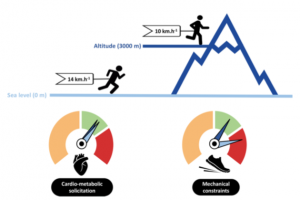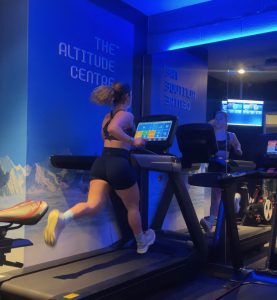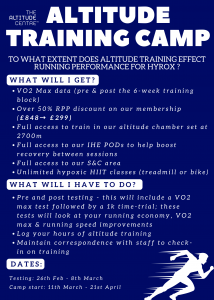In the world of competitive fitness, where athletes are constantly seeking an edge to enhance their performance, altitude training stands as a powerful tool.
Hyrox, the ultimate challenge in functional fitness, demands athletes to sustain high-intensity efforts across various modalities, with running playing a pivotal role in the race. Establishing a robust foundation of running endurance is crucial for success in a Hyrox race.
Traditionally run training for Hyrox compromises of 3 main types of training
- Zone 2 training: low intensity running over a sustained period
- High Intensity Interval Training: alternating periods of high-intensity work with short periods of recovery.
- Threshold Training: the highest sustainable intensity
These work to improve your VO2 max (maximum oxygen utilisation- a measure of fitness) & Lactate threshold (a physiological measure of fatigue) both of which are pivotal in enabling athletes to push harder for longer.
The unique challenge that hyrox athletes face is balancing run training alongside strength and hyrox specific workouts, avoiding fatigue from running training carrying into the quality of strength training sessions.
This is where altitude training can work to manage these potentially challenging factors as well as working to elevate the fitness aspects of training.
Where does altitude training fit into this approach to training?
Our altitude chamber is set at 2700m, the perfect height to balance the benefits of altitude training with the need for an effective workout. Training in this reduced oxygen environment stimulates adaptations that carry over to sea-level performance.
Essentially this means you get more “bang for your buck” from doing the same session at altitude compared to sea level.
Just like adding weight to your back squat increases the training stimulus, exercising at altitude means that you get an increased stimulus from your run.
This is not only useful for improving oxygen efficiency around the body, but also of value from a load perspective. You will achieve the same physiological adaptations as a sea level session, without working as hard!
World champion Hyrox athlete Hunter McIntyre goes to his cabin in Big Bear California (2,058m) to reap the benefits of training at altitude in the lead up to Hyrox world championships.
That’s not possible for everyone so here is how you can benefit of training at altitude right in the heart of central London
Intermittent Hypoxic Exposure:
Altitude can even introduce new types of training you wouldn’t do at sea level. IHE is a passive form of altitude training that we have at our London site. The 60-minute session involves 5-minute periods of hypoxic air (4100-6200m) followed by 5 minutes of sea level air.
Why do IHE?
The alternating periods of hypoxic followed by normoxic air act as a great addition to aid recovery between sessions. The IHE PODs increase blood flow, allowing oxygen rich blood to get into your muscles. This ensures the essential nutrients gets to the muscles to help them recover more quickly.
So, let’s look at how you could implement altitude training into your typical Hyrox training program.
Zone 2 work: Hyrox training can be tough. It is important to ensure you include lower intensity, longer duration, aerobic work in your training program. This will help you build a solid aerobic base. Doing your easy runs or even walking at altitude is going to help to enhance oxygen delivery & utilisation.
Zone 2 work forms the foundation of your training pyramid. The ‘wider’ or bigger your aerobic capacity is, the harder you are going to be able to work in your high intensity sessions, and the greater volume of training you will be able to tolerate overall. Hyrox demands high intensity sustained over a long period of time.
Training in Zone 2 at altitude works to enhance your aerobic capacity, promoting adaptations to enhance the transfer of oxygen at every stage of the oxygen cascade; from improving uptake & delivery.
High Intensity Interval Training & Threshold Training: The decreased partial pressure of oxygen at altitude makes it harder to provide your muscles with the oxygen they require during your high intensity intervals.
This makes your body work harder allowing you to get into higher heart rate zones with less effort- important for managing training load across more intense blocks of training.

What does this all mean for a Hyrox athlete looking improve their performance?
- Improved running economy (lower heart rate at a given speed)
- VO2 max (improved oxygen efficiency)
- Improved speed
- Improved lactate threshold (fatigue less quickly)
- PBs!!
Do you want to see how altitude training can enhance your performance?
By incorporating altitude training into your regimen, you’re working to gain that competitive edge setting you apart from other Hyrox racers on race day.
From the 26th February The Altitude Centre are running a training camp to help with exactly this.

How will the training camp work?
- Testing: Firstly, you will come in for VO2 max testing followed by a compromised 1k run time trial- to mimic the fatigued state you’ll be running in during hyrox racing.
- Training: Following this you will be given all access membership to The Altitude Centre to reap the benefits from our altitude chamber, PODS & strength & conditioning area
- Retesting: After this block your VO2 max will be retested along with another 1k run time trial
What will you receive from training at The Altitude Centre?
- A VO2 max test both before and after the training camp
- Individualised heart rate training zones
- Full access to training in our altitude chamber at 2700m
- Full access to IHE PODs
- Full access to strength & conditioning area
- Unlimited hypoxic HIIT classes
- Over 50% discount on our membership

This means you’ll have a measurable way to look at the effect the positive effects that training at altitude has on your performance
